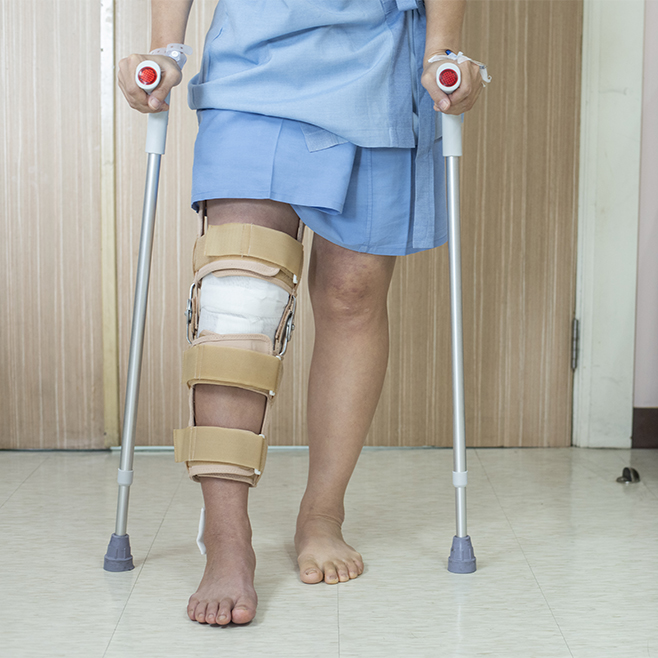Upper & Lower Extremity Reconstruction Surgery: Treating Injuries, Infections, & Birth Defects
Extremity reconstruction surgery can be life-changing for people whose hands, arms or legs have been affected by cancer, an infection, a traumatic injury, congenital (birth) defect, or other conditions.
At University of Utah Health, our experienced, fellowship-trained plastic surgeons offer specialized extremity reconstructive surgeries that are not available at most hospitals. These include microvascular surgery techniques that will:
- repair damaged blood vessels,
- repair damaged nerves, and
- reconstruct damaged soft tissues and bones.
Our plastic surgeons believe that the repaired limb’s appearance and function are important for the final outcome and wellbeing of the patient. We will create a personalized surgical plan that helps you experience the best results possible.
U of U Health plastic surgeons provide extremity reconstruction surgery for patients of all ages — from children and adolescents to adults. We work closely with specialists from other disciplines, including orthopedic surgeons, vascular surgeons, physical therapists, wound care specialists, and others to help our patients live life to the fullest after surgery.
What Is Extremity Reconstruction?
Our plastic surgeons specialize in performing reconstruction surgeries for:
- upper extremities (everything from your shoulder down to your finger tips) and
- lower extremities (everything from your hips to your toes).
These surgeries require a great deal of technical skill to repair your bones, tendons, muscles, blood vessels, nerves, and skin. Some patients only need one surgery, but those with more complex concerns may need a staged approach (multiple surgeries).
Candidates for Extremity Reconstruction Surgery


Reconstruction surgery may be an option for people whose arm or leg is affected by:
- a traumatic injury,
- a non-healing wound,
- an infection or other condition that has caused bone or soft tissue loss,
- surgery to remove a tumor, or
- nerve damage.
If there is concern that one of your limbs needs to be amputated, our plastic surgeons specialize in limb salvage techniques and may be able to prevent amputation with reconstructive surgery. They often work together with our orthopedic and vascular surgeons to save your bones and soft tissues.
However, if amputation is necessary, our nerve specialists will help redirect the nerves to help prevent painful scarred nerve ends (neuromas) and phantom limb pain (a painful sensation that you feel in a body part that no longer exists) through a procedure called targeted muscle reinnervation.
Find a Plastic Surgeon
Upper Extremity Reconstruction Conditions
Traumatic Hand Injuries
- Fractures of the hand and wrist, including fractures that did not heal properly
- Deep wounds
- Tendon injuries
- Blood vessel injuries
- Severed fingers and hands
- Nerve injuries and nerve compression conditions
Congenital Hand Conditions (Birth Defects)
- Polydactyly (extra fingers)
- Syndactyly (when two or more fingers are fused)
- Thumb hypoplasia (small thumb or no thumb)
Other Types of Upper Extremity Conditions
- Arthritis — Swelling and tenderness of one or more joints of the hand or wrist
- Bone and soft tissue reconstruction concerns after tumor/cancer removal
- Carpal tunnel syndrome — Numbness and tingling in the hand and arm caused by a pinched nerve in the wrist
- Cubital tunnel syndrome — Numbness and tingling in the wrist, hand, ring finger, and pinkie finger that is caused by pressure on the ulnar (“funny bone”) nerve at the elbow
- de Quervain’s tenosynovitis — Swelling and pain of the tendons on the thumb side of the wrist
- Dupuytren’s contracture — Thickening and stiffness of the soft tissues that lie under the skin of the palm, which can limit movement in the fingers
- Guyon’s canal syndrome — Tingling and loss of feeling in the hand caused by a pinched ulnar (funny bone) nerve as it passes through the wrist
- Infections (such as flexor tenosynovitis)
- Raynaud’s phenomenon — Poor blood flow that causes the fingers to change colors, hurt, and feel numb and cool
- Skin cancer (such as melanoma, squamous cell or basal cell carcinoma, including reconstruction after Mohs surgery)
- Spasticity — Muscles become stiff, tense, and difficult to move at times
- Trigger finger — One of your fingers gets stuck in a bent or straight position
- Tumors, masses, and ganglion cysts (ganglion cysts are non-cancerous lumps that typically form in the fingers or wrist)
Lower Extremity Reconstruction Conditions
- Traumatic injuries (such as soft tissue injuries with or without a broken bone or injuries of the muscle, blood vessel, or nerve)
- Non-traumatic injuries (such as open wounds related to diabetes or bone or soft tissue infections)
- Bone and soft tissue reconstruction concerns after tumor/cancer removal
- Post-amputation concerns (such as poor contour, which makes prosthetic fittings difficult, painful nerve stumps, or phantom limb pain)
What to Expect at Your First Appointment
During your evaluation, the plastic surgeon will talk to you about your concerns, do a physical exam, and discuss treatment options with you. Extremity reconstruction can be complex and every patient is different. The surgeon may recommend that you have physical therapy before surgery or use assistive devices, such as a brace or splint. If surgery is recommended, we will discuss the risks and benefits and what you can expect in terms of the healing process.
The plastic surgeon may collaborate and coordinate your treatment plan with other specialists such as:
- an orthopedic surgeon,
- neurosurgeon,
- vascular surgeon,
- wound care physician,
- physical medicine and rehabilitation physician,
- physical and occupational therapists, or
- another provider.
Types of Surgical Techniques & Therapies
Plastic surgeons at U of U Health specialize in microsurgery, a technique that uses a microscope to reconnect blood vessels or nerves and repair other tissues.
Some of our plastic surgeons have advanced training in hand surgery using microsurgical techniques and other types of extremity reconstruction surgeries, including:
- Flap reconstruction —This technique moves healthy, live tissue from one location on your body to another, typically to areas that have lost skin, fat, muscle, or bone.
- Limb replantation — This surgical technique reattaches your fingers, hands, toes, or feet.
- Nerve & blood vessel reconstruction — This surgery will restore blood flow and nerve activity after a traumatic injury or blood clot.
- Targeted muscle reinnervation (TMR) — This technique will help people after amputation of the upper or lower extremities to overcome phantom limb pain and residual limb pain that comes from neuromas (scarred nerve ends). It also can help provide better control of prosthetics.
Office-Based Therapies
Our plastic surgeons can do many hand surgery procedures in the office setting thanks to a technique called “wide-awake local anesthesia, no-tourniquet surgery” (WALANT). This means no fasting or general anesthesia (put to sleep). You can drive yourself home afterward, and get back to your everyday activities much sooner. WALANT is available for many minor surgeries, such as carpal tunnel surgery, trigger finger release, and the removal of small lumps or ganglion cysts.
We also offer Xiaflex injections for people with Dupuytren’s contracture, a condition that pulls one or more fingers into a bent position. These injections help straighten the fingers, along with other non-invasive therapies such as daily finger exercises. Injection therapy is an alternative to surgery and doesn’t require general anesthesia.
What to Expect during Your Surgery
Our team will schedule your extremity reconstruction surgery at a U of U Health location and provide you with written instructions to help you prepare. If your surgery requires general anesthesia, you will not be able to eat or drink anything after midnight the day before surgery. You may need to discontinue some of your regular medications before surgery. If so, the care team will let you know.
Depending on your surgery, you may return home the day of surgery or stay at the hospital for part of your recovery. Aftercare differs for every person, so our team will talk to you about what to expect during the healing process and how to care for your surgery site. The surgeon may refer you for physical therapy, occupational therapy, or hand therapy to help build your mobility, flexibility, and strength.
Your recovery process will take anywhere from a few days to a few months, depending on how complex and extensive your surgery was. Your plastic surgeon will let you know what to expect.
Make an Appointment with One of Our Surgeons
Referrals are welcome but not necessary for people seeking a plastic surgery evaluation at U of U Health. To make an appointment with a plastic surgeon at U of U Health, call 801-581-7719. For hand conditions, please call 801-585-HAND.
Before your first appointment, a member of our staff will talk to you on the phone about your insurance coverage, condition, and what tests or imaging studies you have already had. We will obtain any test results and imaging reports that are not in our U of U Health electronic medical record system.

